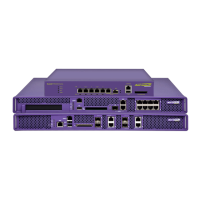AP Management from Controller
Summit WM3000 Series Controller System Reference Guide490
Either import the configuration manually to other APs or the same AP later (if you elect to default
its configuration). Use DHCP option 186 and 187 to force a download of the configuration file during
startup (when it receives a DHCP offer).
When an AP is adopted over an IP Sec Tunnel you cannot export the configuration file to a system on the other
side of the IP Sec Tunnel. You may still export the configuration file to a system local to the AP
Adopting an AP Using DHCP Options
An AP can be adopted to a wireless controller by providing the following options in the DHCP Offer:
Options 189 and 192 are mandatory to trigger adoption using DHCP options. Option 189 alone won’t work. These
options can be embedded in Vendor Specific Option 43 and sent in the DHCP Offer.
Controller Configuration
An Extreme Networks wireless LAN controller can use default values to adopt an AP, as long as a valid
license is installed.
In default mode, any AP adoption request is honored until the current controller license limit is reached.
If you want to control which AP to adopt, disable the controller’s Adopt unconfigured radios automatically
option and manually add APs requiring adoption.
To disable automatic adoption on the controller:
1 Select Network > Access Point Radios from the controller main menu tree.
2 Select the Configuration tab (should be displayed be default) and click the Global Settings button.
Option Data Type Value
189 String <Controller IP Address or Range of IP addresses separated by
[, ; <space>]>
190 String <Fully qualified Domain Name for the Wireless Controller>
191 String <Hashed IPSec Passkey - configure on 1 AP and export to get hashed
key>
192 String <Value of "1" denotes Non-IPSec Mode and "2" denotes IPSec Mode>

